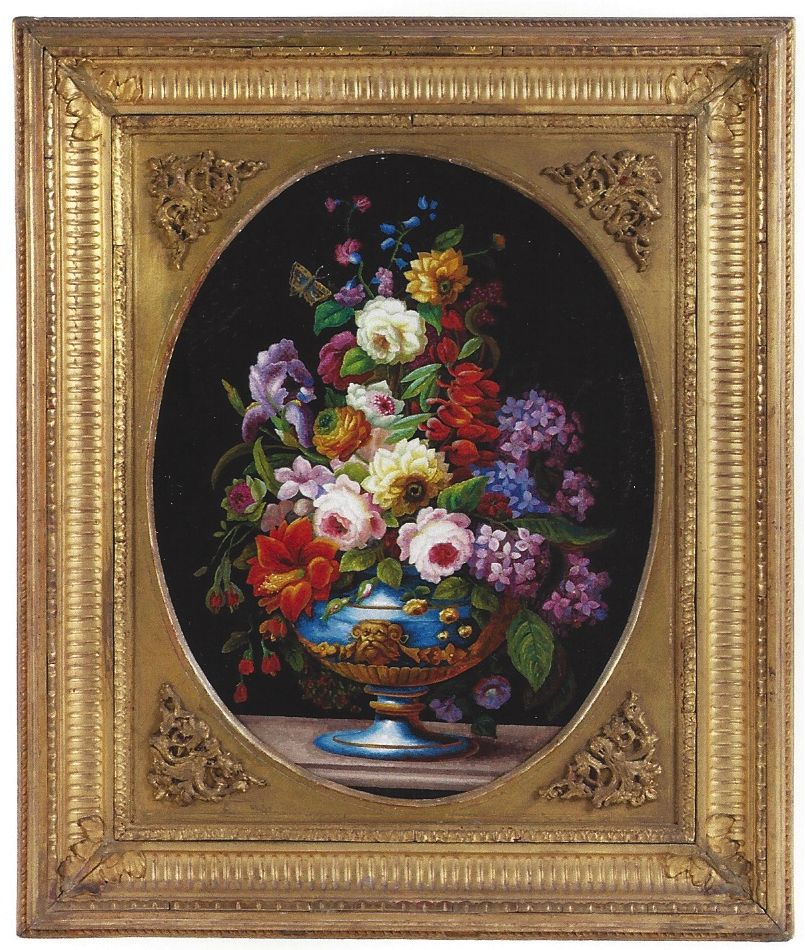The micromosaic plaque signed RFSPV for the Studio Vaticano del Mosaico, circa 1850-60
Micromosaic: 22 5/8 x 17 ¾ in (56.5 x 45.5 cm)
Provenance
Kaiser Friedrich III Hohenzollern
The collection of Mrs Gordon C. Thorne (Chicago), 1967
Private collection, USA
The meuble à hauteur d'appui is a perfect example of the Second Empire style which prevailed in France during the reign of Napoleon III (185270). A stock label has been preserved on the verso of the cabinet, which reads: 'Kaiser Friedrich Pal[…]/ Zimmer N. 2 (?) / Lfde N. 4 (?)'. Kaiser Friedrich III Hohenzollern (183188), was Emperor of Germany for 99 days from 9 March to 15 June 1888. He frequently visited Italy where he was received by the Pope, toured the Vatican galleries and stayed at the Palazzo Caffarelli with the Prussian ambassador. The label indicates that this piece was part of the furnishings of the palace inhabited by the imperial family, perhaps the Kronprinzenpalais (Crown Prince's Palace) in Berlin.
In 1858 Friedrich III married Princess Victoria (Vicky), eldest daughter of Queen Victoria. Her son William II (18591941) was the last Emperor of Germany. Following defeat in the First World War, he abdicated and retired in exile to Huis Doorn in Holland (1919). The possessions of the Prussian court which had remained the property of the Hohenzollern were transferred with him to the new seat of residence, or sold.
At some point the meuble à hauteur d'appui entered into the possession of the Thorne family. In 1967 it appeared in the sale of Mrs Gordon C. Thorne's collection. The work features in the auction catalogue of 23 May 1967 at the Chicago Art Galleries, where the catalogue illustrates it in situ in Mrs Thorne's dining room.
The meuble à hauteur d'appui features a tripartite body with a larger central section fitted with a door, inset with a large oval micromosaic, and shelves to either side beneath rounded front corners. The body is richly ornamented with ormolu beneath a top composed of rare inlaid marble.
The marble is laid out in concentric frames comprising the following types (from outermost): verde levanto, antique yellow, antique red, cipolin, green serpentine, pavonazzetto (these last three used in the frieze of diamond and square shapes in the middle frame), marine cipolin and onyx.
The central door is framed by a pair of columns, each tapering towards the top and inset with ormolu beading, surmounting stylised capitals and knops, above a Solomonic-style column intertwined with laurel leaves. The bases, capitals and decorations of the columns are all in ormolu. The frames and the purfling which complete the decoration are of the same material, both along the exterior and interior.
The micromosaic panel is a unique work of art in its own right and the decision to use it to decorate a cabinet would have been made independently. It is identified as the Roman work of the Studio Vaticano by the crest of the Reverenda Fabbrica di S. Pietro (RFSPV). Its formal and technical characteristics are typical of the style fashionable in the first half of the 19th century. The micromosaic comprises tiny tesserae of spun enamel of different shapes, laid down to create complex textures. Elongated, curving tesserae are used to form the flowers and square shaped ones for the background where they form an elegant lattice of concentric lines. The chromatic range of the enamels is extraordinary.
The floral design owes much to Flemish painting of the 17th century. The treatment of the subject here, with the flowers densely jostling together, intensifies their vitality. Roses and dahlias with great corollas entwine with ranunculus, lilies, wild pansies, freesias and forget-me-nots. The blue vase with gilded contours is reminiscent of a classical vase with raised handles and a circular foot. It bears the crest of the RFSPV (the Pope's crown and keys) as its main decoration.
With its rich decorative body, the taste for chromatic contrast and the combination of diverse materials, this cabinet reflects the style of the French cabinet-makers who were active at the time of Napoleon III, in particular Mathieu Befort, Charles-Guillaume Diehl, the brothers Grohé and George Alphonse-Bonifacio Monbro.
The vase of flowers on a black background of enamel threads, or of Black Belgian marble, represents an iconographic genre which was highly popular in the micromosaic tradition of the 19th century. Several important, well-known examples of such works have an affinity with this cabinet: two signed by Michelangelo Barberi and dated 1836 (private collection), and four examples in the Gilbert Collection (two ovals dated 1850 and two oblongs dated 1860 and 1870). One of the two Gilbert ovals uses the same model of blue vase but with a gilded mask in place of the RFSPV crest.
At the prestigious Universal Exhibitions which were held in London in 1862 and in Paris in 1867 the RFSPV presented, among other things, mosaics in spun enamel portraying flowers, confident that its reputation would be upheld by these works.
Federico Campanili (active from 1858 to 1902) was the artist of the Studio Vaticano del Mosaico who excelled in the floral genre in the second half of the 19th century. According to the archives, he entered the Laboratorio Vaticano in 1858 and was employed, as he himself wrote, on many works depicting flowers in spun enamel as well as others in cut enamel. One of his signed compositions, dating back to the late 19th century, is in a Roman private collection. A sumptuous mosaic with flowers, fruit and pheasant in the Spanish royal collection has also been attributed to him.
The use of the door of a cabinet for a large decoration in micromosaic has only been recorded in one other case, which dates from the beginning of the 19th century. Made in rosewood with marble, hardstones and gilded mounts it bears a mosaic depicting the head of a girl in the guise of Flora, the goddess of Spring. The mosaic is signed by Pietro Polverelli, an artist active in the Studio Vaticano in the second half of the 18th century.






















